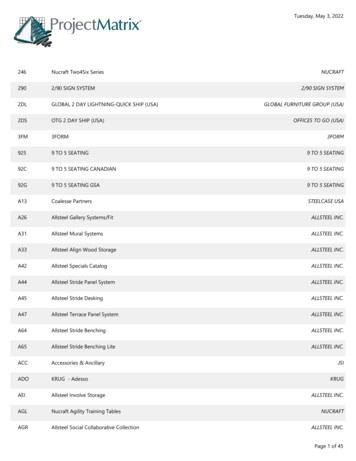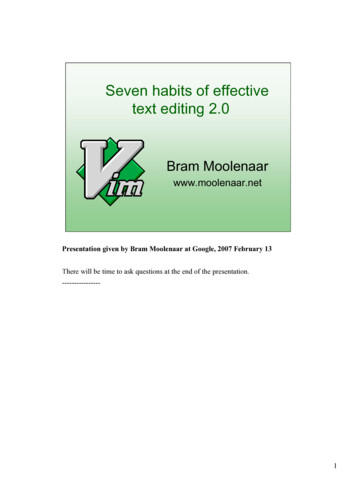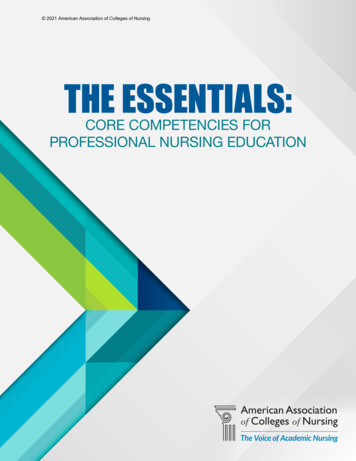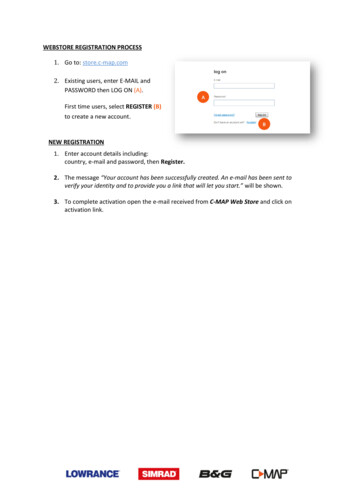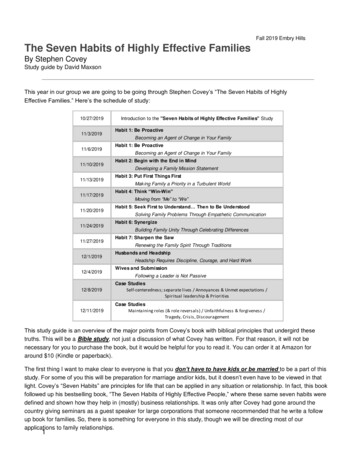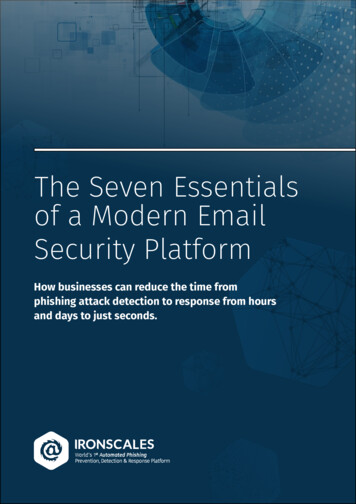
Transcription
The Seven Essentialsof a Modern EmailSecurity PlatformHow businesses can reduce the time fromphishing attack detection to response from hoursand days to just seconds.
The Seven Essentials of a Modern Email Security PlatformIntroductionDid you know that any organization, regardless of size and the number of in-housesecurity personnel employed, can now automatically prevent, detect and respond toall types of sophisticated phishing techniques in real-time. Now imagine how muchtime, money and resources it could save your company and how much burden mightbe alleviated from your Security and IT teams?The reality of email security today, however, is that many businesses do not yetknow that such technology exists or that it is possible to replace or supplement theirexisting solutions with ease. Therefore, most businesses continue to rely on staticsecure email gateways (SEGs) or the baked in security of email service providers,such as Office 365 and G-Suite. While such technologies are proven to reduce somerisk, the frequency at which the email threat landscape now evolves, the highrate of micro-targeted attacks and the speed at which threat intelligence must beconsumed, has significantly reduced the effectiveness of both types of solutions.This playbook introduces CISOs, security teams and analysts, and businessdecision makers to the seven essentials of a modern email security platform, whileproviding objective explanation as to why each essential is necessary and howthey work together. At the conclusion of this paper, the reader will have a greaterunderstanding of:1Why existing cloud and email security solutions are not built for advancedemail phishing threat detection and response2How employees can become a vital layer of detection when incorporatedholistically3Why the open decentralization of human intelligence is the future of emailsecurity4The importance of a closed feedback loop between technical and nontechnical controls5The ability to easily integrate or replace your existing email security stack,while keeping deployment seamlessVisit our websiteFollow us on TwitterFollow us on LinkedIn2
The Seven Essentials of a Modern Email Security PlatformThe Pros & Cons of TraditionalEmail Security ToolsIn order to fully understand why there must be seven essentials of a modern emailsecurity platform, one must first understand the pros and cons traditional emailsecurity tools and how and why such technologies struggle with the pace at whichtoday’s email threat landscape evolves, the high-rate of micro-targeted attacks andthe speed at which threat intelligence must be consumed.While secure email gateways, awareness training, DMARC and manual incidentresponse tools have all proven to reduce risk, each of these technologies alone onlysolves a small piece of what is a very large and complex email security puzzle.Pro: Proven track record of detecting known signature basedattacks (messages containing links and attachments)Secure EmailGatewaysCons: Not built to detect more targeted and sophisticatedfile-less attacks such as Business Email Compromise (BEC),spoofing and impersonation. Also, once an email has landedinside of a mailbox, SEGs struggle to detect and remove themessage.Security AwarenessTrainingPro: Great for building awareness and reducing employeeclick rates.Con: Attackers now deploy social engineering techniquesthat bypass technical defenses, making it almost impossiblefor busy employees to detect or recognize as malicious.DMARC(Domain-basedMessage Authentication,Reporting andConformance)Pro: Built to identify a very specific and complex type ofspoofing (exact domain spoofing)Manual IncidentResponse Tools(Scripts, YARA rules,Signatures, Searchbased tools)Pro: Proven to “clawback” known malicious emails that havealready landed in an inbox.Cons: Only works when both the sender and the receiver arecompliant and the type of attack that it is built to stop, exactdomain spoofing, represents only a tiny subset of all emailspoofing attacks.Cons: Requires significant analyst time to investigateand prompt remediation when time is critical and is alsoinefficient at identifying and stopping polymorphic attacks.Visit our websiteFollow us on TwitterFollow us on LinkedIn3
The Seven Essentials of a Modern Email Security PlatformIntroducing the SevenEssentials of a Modern EmailSecurity PlatformEmail phishing attacks have evolved from a mere nuisance in the early 2000s into themodern-day preferred attack vector for 9 out of 10 cyberattacks. Because of email’sinherent insecurities and with upwards of 156 million phishing emails sent every day,most organizations now recognize the need for robust email security and phishingmitigation tools to ensure business continuity and tangibly reduce risk.To mitigate the widespread risks of email phishing attacks, a modern email security platformmust have these seven essentials:1Advanced malware and phishing/URL link detection2Mailbox-level threat detection (spoofing and impersonation protection)3Human-centric phishing detection4Post-email delivery protection (automatic incident detection & response workflow)5Decentralized crowd sourced intelligence (human vetted intelligence sharing)6Closed feedback loop7One platform, seamless deployment and integration“Enterprises are overly dependent on blocking and prevention mechanisms that aredecreasingly effective against advanced attacks. Comprehensive protection requires anadaptive protection process integrating predictive, preventive, detective and responsecapabilities.” - Gartner“The combination of automated, technology-driven pre-incident protection, post-incidentprotection and incident response is by far the fastest and most effective approach –quantifiably reducing the organization’s risk from phishing attacks by more than 70%, withongoing upside.” – Aberdeen ResearchVisit our websiteFollow us on TwitterFollow us on LinkedIn4
The Seven Essentials of a Modern Email Security PlatformEssential #1ADVANCED MALWARE & PHISHINGURL/LINK PROTECTIONIn the past anti-malware protection such as attachment & URL scanning may havebeen sufficient but today attackers are using more devious and sophisticated attacksby harvesting credentials of users through fake login pages using legitimate domainsthat go undetected. To detect and prevent against zero-days and phishing websitesthat attempt to steal users credentials, email security must provide more than basicsignature detection and blacklists.Advanced malware protection must now not only continuously inspect all inboundlinks and attachments but also utilize computer vision to detect in real-time visualdeviations and determine whether or not a login page is legitimate, automaticallyblocking access to verified malicious URLs.“While the core capabilities of anti-spam and signature-based antimalware may have beensufficient in the past, the threat landscape has shifted to more targeted attacks by hackerswith increasing sophistication and nation-state connections, and those motivated bymonetized cyber intrusions.” - GartnerVisit our websiteFollow us on TwitterFollow us on LinkedIn5
The Seven Essentials of a Modern Email Security PlatformEssential #2MAILBOX-LEVEL THREAT DETECTION(spoofing and impersonation protection)Prevention technology must work in conjunction with advanced detections toidentify sender impersonations, spoofing and business email compromise (BEC) thatbypass gateway security tools. Absent of strong threat indicators (i.e. a one-to-oneemail from a legit domain to another that does not contain malware or maliciouslinks discussing legit business activities), makes blacklists and blocked email-listsineffective.To detect malicious emails with and without payloads, the technology must havethe capacity to dynamically self-learn mailbox and communication habits too usingmachine learning. This will allow for the detection of anomalies based on both emaildata and metadata (content and context) to improve trust and authentication ofemail communications.“Impersonation attacks are the most difficult to detect and most critical to be solved in thesecure email gateway. Email is not designed to truly authenticate sender identity. Efforts likeDMARC to authenticate domains are not granular enough to authenticate users and do notaddress spoofing, cousin or look-alike domain usage.” - GartnerVisit our websiteFollow us on TwitterFollow us on LinkedIn6
The Seven Essentials of a Modern Email Security PlatformEssential #3HUMAN CENTRIC PHISHING DETECTIONTechnical detection alone is not enough, as email phishing is a human and machineproblem that requires a human and machine solution. However, many businessesare not investing in advanced phishing protection education that can empoweremployees to identify and mitigate socially engineered attacks, such as businessemail compromise. When layered into a holistic defense system, employees canbecome a vital layer of detection.By decentralizing and distributing reported incidents from employees to securityteams, companies can mitigate the risk of malicious emails by working incollaboration, within the same platform. And collaboration isn’t limited to just YOURemployees: imagine having the input and value of others, including leading SOCs andother enterprise security resources.“Defending as a pack has advantages over defending yourself in isolation.” - GartnerVisit our websiteFollow us on TwitterFollow us on LinkedIn7
The Seven Essentials of a Modern Email Security PlatformEssential #4:POST EMAIL DELIVERY RESPONSE(automatic incident detection & response workflow)No prevention and detection will stop every single phishing attack, and with timebeing of the essence for phishing mitigation, any email security technology mustprovide end users(employees) with automated incident response and remediationacross all affected mailboxes.Such technology must also be able to collect email threat data and alerts fromdifferent sources, including other SOC teams around the world and employeereports, so that incident analysis and triage can be performed automatically toimprove efficiency. This helps to streamline responses according to a standardworkflow while making it quick and easy for security analysts to classify reportedemail incidents at the click of a button.“In an era of continuous compromise, enterprises need to shift from a mindset of “incidentresponse” — wherein incidents are thought of as occasional, one-off events — to a mindset ofcontinuous response.” - Gartner“The median time the first user open of phishing emails is less than 2 mins.” - Verizon DBIR reportVisit our websiteFollow us on TwitterFollow us on LinkedIn8
The Seven Essentials of a Modern Email Security PlatformEssential #5DECENTRALIZED ACTIONABLE CROWDSOURCED INTELLIGENCE(human vetted intelligence sharing)Decentralized intelligence sharing within a platform that is actionable throughautomation, empowers organizations to proactively prepare for trending emailphishing attacks.By leveraging an entire virtual global analyst community, decentralization ofintelligence sharing can also help businesses utilize data to prepare for what thenext attack will look like and to proactively prevent similar or trending attacks frominfiltrating or repeat attacks from occurring. This virtual SOC model exponentiallyimproves as the global analyst community grows.“You probably should not be using threat intelligence unless you can act on it. If you can’t acton it, it’s probably not worth consuming that data.”“.The Holy Grail for threat intelligence, like anything in security, is automation, of course, butnot all organizations are equipped to go there just yet.” - Jason Trost, vice president of threatresearch at threat intel firm AnomaliVisit our websiteFollow us on TwitterFollow us on LinkedIn9
The Seven Essentials of a Modern Email Security PlatformEssential #6CLOSED FEEDBACK LOOPOrchestrating threat intelligence from technical and non technical controls intoa continuous feedback loop is critical in preventing phishing emails from goingundetected due to lack of communication between controls.By continuously feeding machines intelligence from multiple sources, both internaland external, such as analysts decisions and employee reports, 3rd party threat feeds,sandbox/threat emulation and crowd sourced intelligence, email security can adaptand get smarter by predicting, preventing, detecting and responding in real-time.To reduce risk, machines driving the platform must constantly and inreal-time be made aware of:1Content – what is being detected by different content scanners ofdifferent companies2Context – what is being detected at the mailbox level3Collaboration of Experts – what is being detected by decentralizedthreat intelligence (i.e., humans)“We can’t escape the fact that humans and machines complement each other and togetherthey can outperform each alone. ML reaches out to humans for assistance to addressintent uncertainty. ML aids humans by supporting administrator awareness and providingassistance to higher-tier SOC analysts.” - GartnerVisit our websiteFollow us on TwitterFollow us on LinkedIn10
The Seven Essentials of a Modern Email Security PlatformEssential #7ONE PLATFORM, SEAMLESS DEPLOYMENT& INTEGRATIONEmail security is saturated with point solutions and scattered semi-automatedtools that require organizations to purchase multiple non-integrated technologies,straining budgets and requiring lots of analyst time and resources.Combining all of the essential functionalities to combat modern email threats intoone single platform that can easily integrate or replace your existing email securitystack, while keeping deployment seamless, scalable and the total cost of ownershiplow is a major benefit to security teams.“Supplement gaps in the advanced threat defense capabilities of an incumbent SEG byadding a specialized product tailored for this purpose, if replacement is not an option. Notall SEG vendors include best-of-breed advanced threat defense capabilities.” - GartnerVisit our websiteFollow us on TwitterFollow us on LinkedIn11
SummaryIn conclusion, the frequency at which the email threat landscape now evolves, thehigh-rate of micro-targeted attacks and the speed at which threat intelligence mustbe consumed, has significantly reduced the effectiveness of secure email gatewaysand the security baked into G-Suite and Office 365.To truly mitigate the risk of email phishing attacks, businesses must look towardstechnology that provides advanced malware and phishing link detection; mailboxlevel spoofing and impersonation protection, human-centric phishing detection,post-email delivery protection and decentralized intelligence that is seamless todeploy and works within a closed feedback loop.About IRONSCALESIRONSCALES multi-layered advanced phishing threat protection platform combinestechnical controls to block as many phishing attacks as possible and end-usercontrols to help users detect more sophisticated attacks at the mailbox-level, whileincorporating employees as part of the defense strategy to detect what is missed bytechnology.Our advanced threat protection platform uniquely combines human intelligence withmachine learning and AI to automatically prevent, detect and respond to advancedemail threats and predict future attacks, so if one control fails, there are others tocompensate while maintaining an adaptive security architecture.IRONSCALES is proven to reduce the time from phishing threat discovery to attackremediation from days, weeks or months to just seconds or minutes.Reduce phishing risk with IRONSCALES advanced phishing threat protection platform,which leads the email security industry in speed, efficacy and durability.Visit our websiteFollow us on TwitterFollow us on LinkedIn
secure email gateway. Email is not designed to truly authenticate sender identity. Efforts like DMARC to authenticate domains are not granular enough to authenticate users and do not address spoofing, cousin or look-alike domain usage." - Gartner


